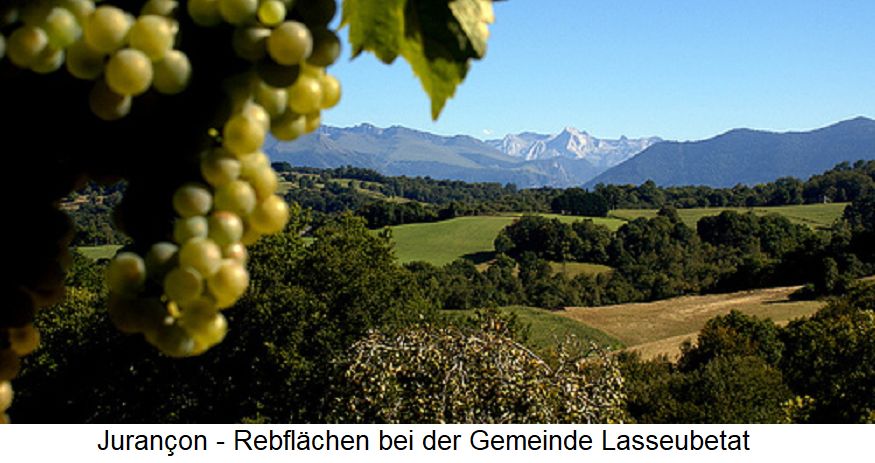Results
2,284 Results
Loading more Results ...
Loading more Results ...
South-west France France
Jurancon AOC
| Jurancon AOC |
Description to Jurancon AOC
The appellation, named after the commune of the same name, is located in the foothills of the Pyrenees in the southwest of the region of Southwest France. It is largely congruent with the Béarn appellation and comprises 25 municipalities in the Pyrénées-Atlantiques département. There was probably already winegrowing here 2,000 years ago, as Roman mosaics from that time suggest. As early as the 14th century, the vineyards of this area were defined as special vineyard sites (cru) by resolution of the Parliament of Navarre. Among other things, it was also forbidden at that time to import foreign wines. This can be seen as one of the first attempts at a classification or protected designation of origin. Incidentally, Jurançon was one of the first French areas to be classified as an AOC at the end of the 1930s. At the baptism of his son and later king and great wine lover Henry IV (1553-1610), the King of Navarre Anton of Bourbon (1518-1562) wetted his lips with wine from Jurançon and rubbed them with a clove of garlic to strengthen the newborn. This baptismal practice, known as the "Baptême Béarnais", was later maintained in the French royal family.

The fact is that the wine from Jurancon established itself as the standard wine for ceremonies of the French ruling house. It was produced in red and white at the time. Phylloxera destroyed most of the vineyards at the end of the 19th century, but afterwards the old varieties were replanted. Jurançon was widely exported to Holland and as far away as America. The famous French writer Sidonie-Gabriele Colette (1873-1954), author of "Chéri" and "Gigi", wrote about it: "As a young girl I made the acquaintance of a prince - warm, imperious and insidious like all great seducers: Jurançon". This, of course, contributed to the fame of the wine.
The vineyards cover around 1,000 hectares on south-facing slopes at 300 to 600 metres above sea level with a relatively cool climate. The vines are trained up to two metres high in espalier style, which protects them from the ground frosts. The long, sunny autumns allow for a very late harvest into December. The traditional Jurançon version, similar to the sweet Sauternes wines, is a concentrated, sweet white wine made from overripe or dried grapes(passerille). The small-berried and thick-skinned grape variety Petit Manseng, which produces extremely low yields of up to only 15 hl/ha (40 hl/ha are permitted), is particularly suitable for this. Only under these conditions can a high-quality sweet Jurançon be produced. Courbu Blanc, Camaralet de Lasseube, Gros Manseng, Lauzet and Petit Courbu are also present in small proportions. The heavy wine is characterised by a balanced acidity as well as longevity.
Jurançon sec was classified as a separate appellation in 1975. This is a dry variant made from the Gros Manseng and Courbu Blanc varieties. This wine can also be produced in years with poor weather conditions and accounts for about three quarters of the production. Both wines have a characteristic greenish hue that deepens with age. Well-known producers in the Jurançon area include Domaine du Bellegarde, Clos Bellevue, Domaine Bordenave, Domaine de Cabarrouy, Domaine de Capdevielle, Domaine Castéra, Domaine Cauhapé, Domaine Gaillot, Clos Guirouilh, Château Jolys, Cru Lamouroux, Clos Lapeyre, Domaine Larredya, Domaine Nigri and Clos Uroulat.
Image: By KERARNO - vignes, CC BY-SA 2.0, Link
Recent wines 5
 Domaine Cauhapé
— South-west France
2018 Jurancon AOC "Ballet d'Octobre"
Domaine Cauhapé
— South-west France
2018 Jurancon AOC "Ballet d'Octobre"

 Domaine Cauhapé
— South-west France
2017 Jurancon AOC "Boléro"
Domaine Cauhapé
— South-west France
2017 Jurancon AOC "Boléro"

The most important grape varieties
More information in the magazine
- Plaimont - The vine rescuers from south-west France Advertisement
- Good Bordeaux doesn't have to be expensive! Crus Bourgeois
- Paradisiacal times! Tasting: European sparkling wines for the festive season
- Liv-ex classification: The fine wine market 2023 France is the measure of all things
- Domaine Combier Collection of the Year 2022 - Rhône
- The collections and discoveries of the year 2022/2023 tasting season
- Social responsibility in the name of wine In Focus: Vignerons Engagés
- AB, Vignerons Engagés, HVE, Terra Vitis: what are the differences? Organic certifications for French wine
- A lot of power for little money In Focus: Côtes du Rhône Villages Rouge
- Saving your account with pleasure In Focus: Crozes-Hermitage

